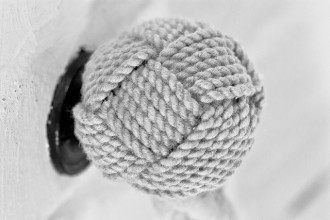
“Lincoln for the Defense” by Norman Rockwell
Image: Norman Rockwell Museum
Given the potential for injury, it comes as little surprise to learn that weighted monkey’s fists were speedily recognised by sailors and others as useful weapons during street and tavern brawls. The rope was shortened and tied around the wrist, so the knot containing the weight could be carried in the hand or pocket. This weapon became known in the 19th century as a slungshot (not to be confused with slingshot).
As most landlubbers are not as practised as sailors at tying knots, improvisation was the name of the game – putting the weight in a leather pouch or, at its most crude, using a billiard ball in a sock.
A slungshot featured in Abraham Lincoln’s famous Almanac Trial in 1858. Lincoln was defending Illinois man William ‘Duff’ Armstrong, who was accused of murdering James Preston Metzker with a slungshot just before midnight on 29 August 1857. The main prosecution witness, Charles Allen, testified that he had witnessed the murder from about 150 feet away, ‘by the light of the moon’.
Lincoln then produced an 1857 almanac to show the jury that on the night in question the moon was only in the first quarter and was low on the horizon, about to set, at the time the crime was committed, so could not have provided enough light for Allen to see anything clearly. Armstrong was acquitted by the jury.
Perhaps as a result, carrying or using slungshots is illegal in several US states. Nevertheless, typing ‘slungshot’ or ‘monkey’s fist weapon’ into a search engine yields numerous ‘self defence’ sites in the UK and elsewhere offering such items for sale, and discussions about how to make your own.

 In Brixton Windmill, at the end of the rope banisters, you may have noticed some decorative knotted balls. These are known as monkey’s fist knots because they look like a small fist.
In Brixton Windmill, at the end of the rope banisters, you may have noticed some decorative knotted balls. These are known as monkey’s fist knots because they look like a small fist.

